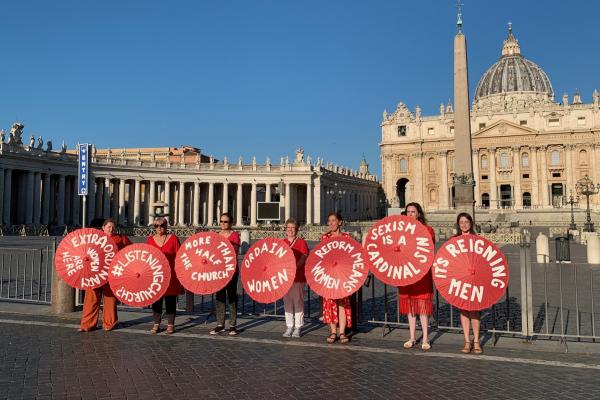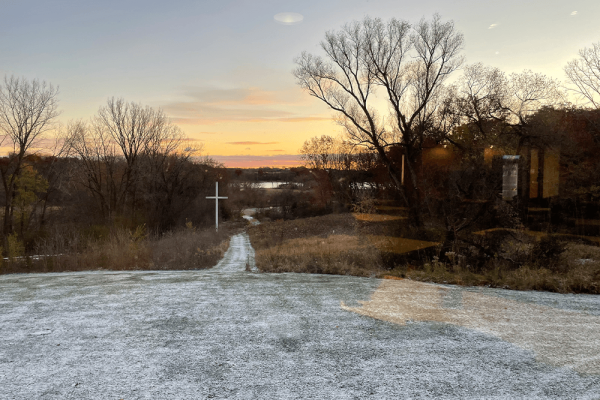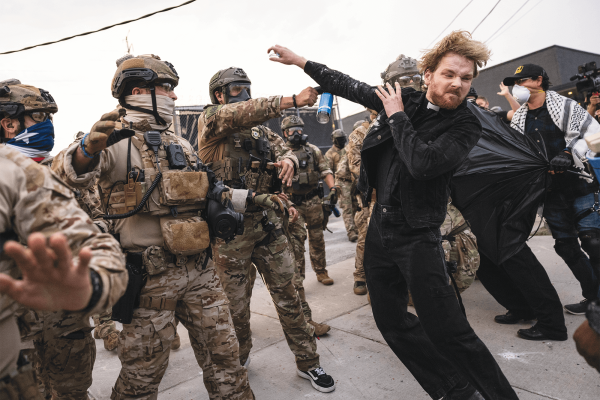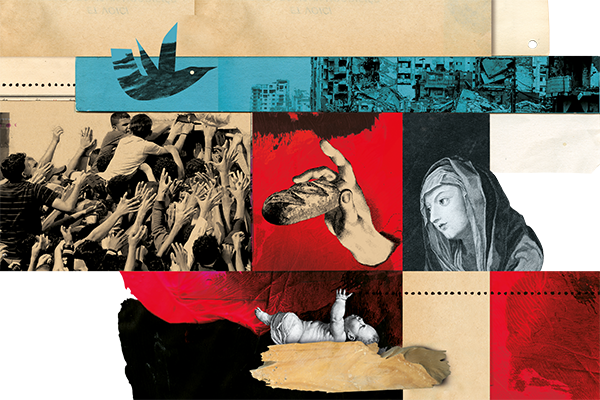On Monday, leaders of two Catholic groups dedicated to women’s ordination in the church reminded Catholic cardinals not to ignore their “sisters outside,” as the cardinals met to discuss church reforms.
Earlier this year, Pope Francis named two women to a dicastery, or papal committee, that selects new bishops in the church. However, Monday’s closed-door gathering of cardinals excluded women.
While cardinals met inside, a small group of women from the U.S.-based Women’s Ordination Conference and Women’s Ordination Worldwide stood at an entrance with bright red umbrellas bearing messages that included “ordain women” and “more than half the church.” They spoke with entering cardinals and handed them a letter explaining their efforts for recognition. Within 10 minutes, police detained the group, holding them for about four hours. Officially, the group was held on grounds of protesting without a permit.
Kate McElwee, the executive director of the Women’s Ordination Conference and one of the women at the protest, spoke with Sojourners’ Mitchell Atencio hours after being released. She discussed her hope for women’s ordination, Francis’ attitude toward reforms, and the symbolic nature of their activism.
This interview has been edited for length and clarity.
Mitchell Atencio, Sojourners: What were the cardinals meeting to discuss?
Kate McElwee: Pope Francis called a consistory and on Saturday, he created 20 new cardinals and [on Monday and Tuesday] he’s calling the world’s cardinals together for meetings. There are 197 prelates [church officials] who are in Rome particularly to discuss the reforms of the new apostolic constitution that was promulgated on Pentecost.
One of the significant reforms of that constitution is that he has opened the possibility for women, or any layperson, to lead dicasteries in the Vatican — this is a role that traditionally had been reserved for bishops and cardinals, so this is a significant move.
I’ve heard the intention [for these meetings is] to have the cardinals meet one another, practice and model synodality, and then get to know the constitutional reforms. But, of course, there are no women in this meeting.
We wanted to witness and just draw attention to the fact that this is a closed-door session where no women are present, ironically, when one of the biggest changes of the constitution is that women can now lead dicasteries
And how did your action go? You and your colleagues were detained for about four hours, what were interactions with police like, why did they say they detained you?
We had a prayer and an intention that our voices would carry through these closed-door sessions and provoke the conscience of the prelates meeting to know that their sisters are waiting outside. We opened bright red parasols with our messages written on them; everything from “reform means women,” “it’s reigning men,” “sexism is a cardinal sin,” and other messages. We processed down Via della Conciliazione till we reached the gates of the piazza, and then continued on to the dicastery for the doctrine of faith, where it’s a major entry point for the Vatican and we thought we could greet cardinals as they entered in.
We had a letter that said, “don’t forget your sisters outside,” but we greeted them very respectfully and were able to interact with a handful of cardinals who were going into their meetings. Some were more supportive than others. But in about 10 minutes various levels police came towards us and asked us to close our umbrellas and provide our identification documents. We complied after a short time, and they penned us into a small [space] between the colonnades. We were there for an hour, and their main complaint was that we didn’t have a permit — I lived in Rome for eight years, it’s very hard to get a permit for women’s ordination next to the Vatican. After an hour they escorted us to the closest police station where we were held for another three hours or so. It was a lot of waiting for them to process us for protesting without a permit, particularly at the Vatican. It was very, very Italian experience. We stopped for coffee before they brought us to the police station. I think they didn’t believe we were dangerous, but it was a matter of bureaucracy and formalities for them.
Why is women’s ordination important in the Catholic church?
It is a matter of justice for most Catholic women. Our calls are not heard. Many women feel like they have no voice or vote in the Catholic church. And there’s layers and layers of sexism that marginalize women from important leadership positions, both ministerial and administrative.
And like me, for so many Catholic women, this is our home. This is our identity and our tradition, and through the sacraments is how we navigate the world. To be considered second tier, or to not have our voices heard, is deeply painful. And we see the effects of this exclusion throughout the world.
One of the most important things about our work is to recognize that women’s ordination isn’t just about women priests. The Catholic church has 1.36 billion members. More than half of those people are women, and they have no representation within the church. That kind of exclusion and subordination is replicated through culture, education, and all the ways the Catholic church has power in the world — including having a seat at the United Nations and working to subvert policies on gender equality.
There’s also a deep pain. In my work, I get to hear the stories and the testimonies of women called to priesthood. You hear their vocational stories and they’re not dissimilar to male priests in any way.
I’m a very hopeful person. I believe that the church can actually be this incredible force for good and justice in the world, if it opened its doors to women.
How would you describe Pope Francis’ relationship to the movement for women’s ordination?
I think Pope Francis has done quite a bit to encourage greater dialogue around the question of women in the church, particularly through his Synod on Synodality and engaging all Catholics, to be involved in this collective discernment. In the United States [this] has inspired a lot of these diocese and synod reports to include mentions of the urgent calls for women’s ordination and women in ministry. In that sense, he’s really changed the culture. Because women’s ordination to the priesthood is a taboo in a lot of ways. And through synodality and dialogue that we’re engaging in together, he has opened up that conversation in bigger ways.
Unfortunately, when it comes to women’s ordination, specifically throughout his pontificate, he has repeated the logic and thinking of his predecessors. Although he has convened two commissions on women deacons, [and] that is still an evolving question in the Catholic church, on priesthood I think Francis hasn’t moved much, [even though] he has encouraged greater dialogue and called for greater inclusion of women in the life of the church.
What gives you hope that this is possible?
When I think about Pope Francis, he is a man who has changed his mind. He is leading the global church in collective discernment, which is so messy, but it means this is all in play, this is all in conversation. There’s a great opening for the church leaders to really listen to Catholics on the ground. The majority of Catholics are calling for women’s ordination and greater leadership roles in the church. That gives me a lot of hope.
As part of the synod on synodality, the Vatican’s Synod office listed the Women’s Ordination Conference’s resources on their official website, which, would be unthinkable in a different pontificate. That means that this is part of the conversation, the elephant in the room is on the table up for discussion. As long as we’re still talking about this — and we are because this question has not gone away in so many decades — that there’s still hope.
We’ve seen Pope Francis really model what a pastor is. I believe Francis is a quite a pastoral person. So part of my work is to create opportunities where he can hear the testimonies and vocations of women. He formalized the ministry of catechists recently and has opened the role of acolyte and lector to women, and that language really identifies discerning a vocation. When I read that language, I think that’s the same spirit that calls women to ordained ministry. I just hope that he’s open to hearing the calls of women to ordination. Unfortunately, when you’re surrounded by the architecture of the Vatican, interaction with women — particularly if you call these meetings of only men — can be quite limited.
What has it meant to you to do this work internationally and across cultures?
It’s absolutely essential. When you get to meet women in different cultures and listen to the language that they use to describe their longing for leadership and ministerial roles, there are nuances, but women around the world are just longing for equality for their voices to be heard.
The particularities of circumstances make priorities different, but at the core it’s that women are longing to be equal and to be embraced in by their own church. It’s very powerful to work alongside international women and leaders who are coming with their own context and their own stories. This can’t come from one place. This is a universal church. It’s part of that discernment that Francis is trying to model and lead us through. Listening to the voices and the context of all of women in different places is really important to what we do.
Editor’s note: This story was updated to correct a transcription error at 7:00 p.m. on Aug 30, 2022. McElwee said the “Vatican’s Synod office.”
Got something to say about what you're reading? We value your feedback!






